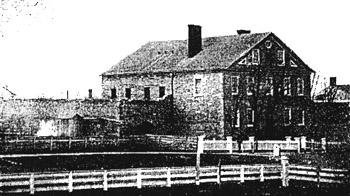|
The History of the Ontario County Jail: 1789 - 1995
In attendance were Sheriff Judah Colt, Judge Oliver Phelps, and Grand Jury Foreman George Codding. It is believed that Oliver Phelps was the first Judge of Ontario County, self appointed, because of the difficulty in finding men to serve. [2] The first County Jail was erected immediately after the organization of the County. It was a log structure located on or near the southwest corner of the public square, about where the present City Hall is located. . . .
The jail is described as having only one door, with two small windows on each side. In addition, a couple of great chains to which prisoners were fastened, with plenty of straw on the floor for bedding. [4] In the first years of the nineteenth century the jail was shifted to the corner of Main and Coach Streets in Canandaigua. The first hotel called the Pitts Hotel, was a combination jail and hotel. The jail was on the second floor at the front of the building. The windows of the jail were not too far above the street. This made it possible for the inmates to converse with their friends on the street. The first floor of the Pitts Hotel was used as a tavern entertaining paying and orderly guests. [5]
"In those days people were jailed for not paying their bills, and those put in jail were mostly of that kind." The insane man, and the man who could not pay his debts, were subjects of imprisonment. Moses Ward Sr., stated, "In 1803 my father was served, and having nothing with which to make payment, was taken to the old jail." [6] His mother carried provisions from Centreville, as prisoners for debt had to board themselves. A dozen prisoners were confined in the old log jail, and their only crime was poverty. [7] Oliver Phelps, imprisoned for debts, died in the Ontario County Jail February 11, 1809. [8]
Jesse Hawley, a Connecticut Yankee first came to Canandaigua in 1796 as a clerk in the office of Phelps-Gorham. Jesse Hawley and Henry Corl of Geneva formed a partnership, forwarding flour by long, shallow draft Durham boats. The primitive land and water systems was slow, rough going, dangerous and expensive, especially in low water periods of summer. Beset by this, and other economic problems, Hawley was caused to default on his mortgaged Geneva property located at Main and Seneca in what is downtown Geneva today. His partner Henry Corl declared bankruptcy and absconded with $10,000 of partnership assets. Pressing for collection, creditors brought suit against Hawley. Hawley asked a friend to post bail. Free on bail, he panicked. In December of 1806 he fled to Pittsburgh, forfeiting his friend's bail money. Hawley eventually returned voluntarily to Canandaigua. While in the Ontario County Jail, Hawley began writing his fourteen articles on the Erie Canal, under the nom de plume "Hercules" in the Ontario Messenger, now called the Daily Messenger. Ten years after Hawley publicly proposed the canal, ground was broken July 4, 1817 near Rome by Dewitt Clinton. Eight years later on October 26, 1925 the Grand Canal was opened at Buffalo.
|

